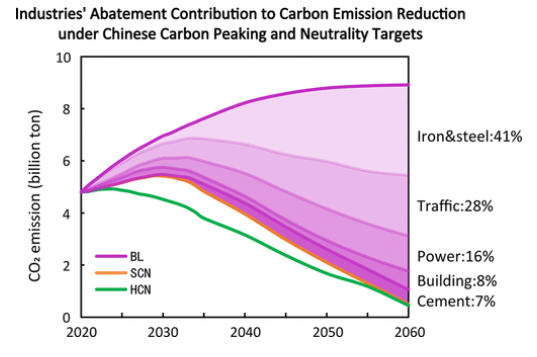

Date issued:2023-03-13
CAEP explore the peaking and neutralization path and cost-effectiveness of China's key industries in《ES&T》
The Center for Carbon Neutrality ,Chinese Academy of Environmental Planning (CAEP), together with Nanjing University, Beihang University, IIASA、Utercht university,Tsinghua University, Beijing Normal University and Shanxi University, published a paper Closing the Gap between Carbon Neutrality Targets and Action: Technology Solutions for China’s Key Energy-Intensive Sectors in《Environmental Science & Technology》. In this study, we first established the CNTD platform to support the development of the “bottom-up” energy and climate integrated assessment models. Based on the platform, we then developed the MESSAGEix-CAEP model and analyzed the decarbonization pathways for each industry, as well as their interactions. Finally, we revealed the marginal abatement cost curve for industries and conducted a cost-benefit analysis under the SCN and HCN scenarios.
Closing the Gap between Carbon Neutrality Targets and Action: Technology Solutions for China’s Key Energy-Intensive Sectors
Jinchi Dong, Bofeng Cai, Shaohui Zhang*, Jinnan Wang*, Hui Yue, Can Wang, Xianqiang Mao, Jianhui Cong, and Fei Guo
Abstract:Facing significant carbon emissions annually, China requires a clear decarbonization strategy to meet its climate targets. This study presents a MESSAGEix-CAEP model to explore Chinese decarbonization pathways and their cost-benefit under two mitigation scenarios by establishing connections between five energy-intensive sectors based on energy and material flows. The results indicated the following: 1) Interaction and feedback between sectors should not be disregarded. The electrification process of the other four sectors was projected to increase electricity production by 206%, resulting in a higher power demand than current forecasts. 2) The marginal abatement cost to achieve carbon neutrality across all five sectors was 2189 CNY/tCO2, notably higher than current Chinese carbon emission trading prices. 3) The cost-benefit analysis indicates that a more ambitious abatement strategy would decrease the marginal abatement cost and result in a higher net carbon abatement benefit. The cumulative net benefit of carbon reduction was 7.8 trillion CNY under ambitious mitigation scenario, 1.3 trillion CNY higher than that under current Chinese mitigation scenario. These findings suggest that policy-makers should focus on the interaction effects of decarbonization pathways between sectors and strengthen their decarbonization efforts to motivate early carbon reduction.
Keywords:carbon peaking,carbon neutrality, ,marginal abatement cost,social cost of carbon, cost-benefit analysis

 Comments
Comments




 Home
Home

 京公网安备 11010702002483
京公网安备 11010702002483